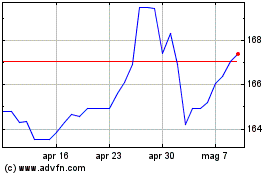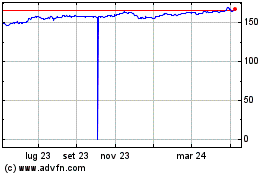UK Private Sector Expands At Record Pace In May
21 Maggio 2021 - 8:51AM
RTTF2
The UK private sector expanded in May at the fastest pace since
records began two decades ago, underpinned by easing of pandemic
restrictions and high levels of pent up demand, flash survey
results from IHS Markit showed on Friday.
The Chartered Institute of Procurement & Supply composite
output index rose to 62.0 in May from 60.7 in April. The score
matched economists' expectations.
This was the highest reading since the index was first compiled
in 1998. A reading above 50 indicates expansion in the sector.
Survey respondents widely commented on a post-lockdown bounce in
business and consumer confidence, alongside higher output levels
due to the phased reopening of customer-facing areas of the UK
economy.
The performance of private sector business is hugely encouraging
even with the obstacles of Brexit and Covid still in place, and
becoming more resilient at a rate of knots, Duncan Brock, group
director at CIPS, said.
"Had supply chains been less squeezed and the weather more
seasonal for hospitality particularly, progress would have been off
the scales," Brock added.
The lofty levels of the composite PMI seen in recent months
probably has a little further to run as the reopening of indoor
hospitality for the full month means the services PMI has scope to
rise further in June, Kieran Tompkins, an economist at Capital
Economics, said.
The flash manufacturing Purchasing Managers' Index rose to a
record 66.1 in May from 60.9 in April. Economists had forecast the
index to fall to 60.5.
At 61.8, the services PMI advanced to a 91-month high from 61.0
in April. The expected reading was 62.0.
Looser pandemic restrictions and high levels of pent up demand
meant that a swift turnaround in labour market conditions continued
in May. The private sector employment increased at the quickest
pace since June 2014.
Cost pressures were the strongest for nearly thirteen years.
Subsequent efforts to protect margins resulted in the sharpest
increase in average prices charged by UK private sector firms since
this index began in November 1999.
Further, business expectations for the next 12 months edged up
to a new record high in May.
Grafico Cross Euro vs Yen (FX:EURJPY)
Da Mar 2024 a Apr 2024

Grafico Cross Euro vs Yen (FX:EURJPY)
Da Apr 2023 a Apr 2024
